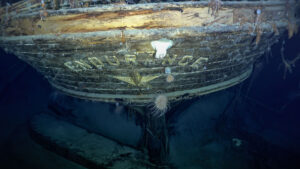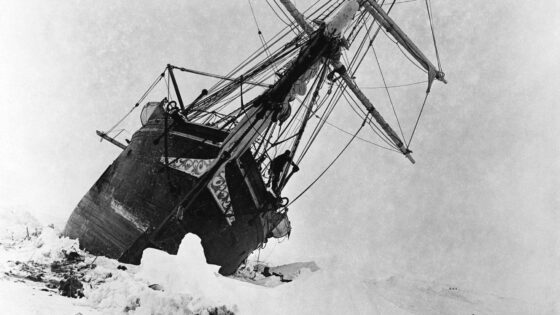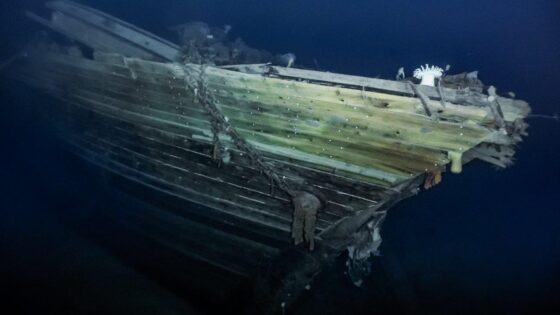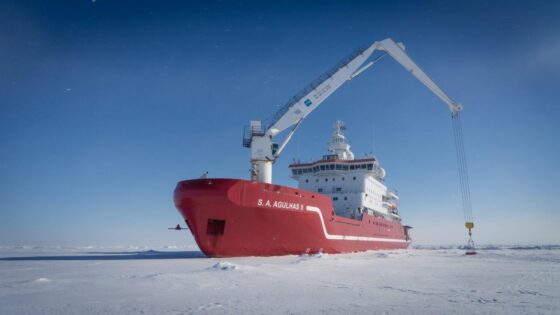
‘Frozen in time’ – wreck of Shackleton’s Endurance found after 107 years

Endurance, the lost ship of Antarctic explorer Sir Ernest Shackleton, has been found 107 years after it sank.
Widely considered one of the greatest of all undiscovered wrecks, Endurance had not been seen since it was crushed by ice and sank in the Weddell Sea in 1915, forcing Shackleton and his crew to make an infamous escape on foot and in small boats.
The Endurance22 project to find the lost ship was mounted by the Falklands Maritime Heritage Trust (FMHT), using the South African polar research and logistics vessel, Agulhas II, equipped with remotely operated submersibles. It has been one of the most complex subsea projects ever undertaken, with several world records achieved during the mission that has been led by an international team of scientists.

The 44m long Endurance was trapped by ice for months, before eventually sinking in 1915
For over two weeks, submersibles had combed a predefined search area, before finally uncovering the wreck site on Saturday — the 100th anniversary of Shackleton’s funeral.

Photo courtesy of Falklands Maritime Heritage Trust and National Geographic
“This is by far the finest wooden shipwreck I have ever seen. It is upright, well proud of the seabed, intact, and in a brilliant state of preservation. You can even see Endurance arced across the stern. This is a milestone in polar history,” says Mensun Bound, director of exploration on the mission.

Photo courtesy of Falklands Maritime Heritage Trust and National Geographic
Endurance was found at a depth of 3,008m in the Weddell Sea, approximately four miles south of the position originally recorded by Captain Worsley. The days since the discovery have been spent making a detailed photographic record of the timbers and surrounding debris field.

Photo courtesy of Falklands Maritime Heritage Trust and National Geographic
In the video below, German sea ice physicist Dr Christian Katlein, a member of the expedition team, reports from the site and shares remarkable footage from the wreck.
“We had covered around 80 per cent of our search box and were starting to get a bit sad that we might not find it,” Katlein says. “There were already some discussions about whether we were going to return for another expedition … but actually, we found it and we were extremely lucky. It was a great team effort from many people from many nations. It’s just insane. The robots have been working consistently for two weeks without any technical failure.”
Katlein says the team nows plan to spend “a few days” surveying the wreck, before heading back to Cape Town.

Saab’s Sabertooth hybrid underwater search vehicles have been searching for the wreck day and night. Photo courtesy of Esther Horvath and Falklands Maritime Heritage Trust
The wreck is protected as a Historic Site and Monument under the Antarctic Treaty, ensuring that whilst the wreck is being surveyed and filmed it will not be touched or disturbed in any way. No physical artefacts have been brought to the surface.
The ship looks remarkably similar to how it did in images taken by Shackleton’s filmmaker, Frank Hurley, in 1915. While some damage is evident to the masts and at the bow, there is little wood deterioration, thanks in part to the cold conditions and lack of any wood-eating organisms in the Southern Ocean. The anchors are present, and even boots and crockery have been spotted.
 SA Agulhas II
SA Agulhas II, captained by Knowledge Bengu, had been searching for the vessel for two weeks. Photo courtesy of Falklands Maritime Heritage Trust
“Our objectives for Endurance22 were to locate, survey and film the wreck, but also to conduct important scientific research, and to run an exceptional outreach programme,” says Donald Lamont, chairman of the Falklands Maritime Heritage Trust. “Today’s celebrations are naturally tempered by world events, and everybody involved in Endurance22 keeps those affected by these continuing shocking events in their thoughts and prayers.”
 SA Agulhas II
SA Agulhas IIis a South African polar icebreaker with state of the art technical equipment on board. Photo courtesy of Falklands Maritime Heritage Trust
Bound adds: “We are overwhelmed by our good fortune in having located and captured images of Endurance. However, it is not all about the past; we are bringing the story of Shackleton and Endurance to new audiences, and to the next generation, who will be entrusted with the essential safeguarding of our polar regions and our planet.
“We hope our discovery will engage young people and inspire them with the pioneering spirit, courage and fortitude of those who sailed Endurance to Antarctica. We pay tribute to the navigational skills of Captain Frank Worsley, the Captain of the Endurance, whose detailed records were invaluable in our quest to locate the wreck.”

Photo courtesy of Esther Horvath and Falklands Maritime Heritage Trust
The Weddell Sea is covered in thick sea-ice year-round, which is one of the factors that had made the mission to locate Endurance so challenging. However, the BBC’s science correspondent Jonathan Amos reports that this past month has seen the lowest extent of Antarctic sea-ice ever recorded during the satellite era, which stretches back to the 1970s. The conditions were, therefore, unexpectedly favourable.
Huge credit for #Endurance22 must go to the crew of the Agulhas II (@A_M_S_O_L), captained by the inspirational Knowledge Bengu. Thank you. pic.twitter.com/4IiX4NJqnm
— Dan Snow (@thehistoryguy) March 9, 2022
It was Sir Ernest Shackleton’s ambition to achieve the first land crossing of Antarctica from the Weddell Sea via the South Pole to the Ross Sea. In the Weddell Sea, Endurance never reached land and became trapped in the dense pack ice and the 28 men on board eventually had no choice but to abandon ship.
After months spent in makeshift camps on the ice floes drifting northwards, the party took to the lifeboats to reach the inhospitable, uninhabited, Elephant Island. Shackleton and five others then made an extraordinary 1,300-km open-boat journey in the lifeboat, James Caird, to reach South Georgia. Shackleton and two others then crossed the mountainous island to the whaling station at Stromness. From there, Shackleton was eventually able to mount a rescue of the men waiting on Elephant Island and bring them home without loss of life.
